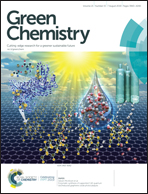Metal-free quinolylation of the primary amino groups of amino acid derivatives and peptides with dihydrooxazolo[3,2-a]quinoliniums†
Abstract
The chemical modification of the primary amino groups of amino acid derivatives and peptides is an important process in the pharmaceutical industry and the field of chemical biology. However, suitable reactions that can be carried out under mild and environmentally friendly conditions are limited. We present a versatile method to selectively modify primary amino groups using novel dihydrooxazolo[3,2-a]quinoliniums in 1-butanol as solvent under mild and metal-free conditions. The application of this method to peptides with primary amino, secondary amino, amide, alcoholic hydroxyl, phenolic hydroxyl, disulfide bond, ester and cyano groups revealed that only the primary amino groups were selectively modified, suggesting that this method is compatible with other reactive moieties. We also demonstrated that the quinolylation of existing peptides affected peptide bioactivity and stability, indicating that the novel dihydrooxazolo[3,2-a]quinoliniums can be widely applied, especially in medicinal chemistry and chemical biology.
![Graphical abstract: Metal-free quinolylation of the primary amino groups of amino acid derivatives and peptides with dihydrooxazolo[3,2-a]quinoliniums](/en/Image/Get?imageInfo.ImageType=GA&imageInfo.ImageIdentifier.ManuscriptID=C9GC01442J&imageInfo.ImageIdentifier.Year=2019)


 Please wait while we load your content...
Please wait while we load your content...